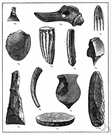Archaeologists and historians explore one aspect of the new narrative that needs to be built, based on emerging evidence for the importance of history making from the later
Epipaleolithic through the Neolithic in the Middle East.
The most dramatic recent discoveries in Cypriot archaeology pertain to the earliest eras of the island's prehistory, the
Epipaleolithic and Early Aceramic Neolithic (EAN) periods, of which Knapp presents a studious and detailed overview in chapter 3.
In Anatolia, the earliest evidence for the practice derives from the
Epipaleolithic occupation layers at Pinarbasi (Baird et al.
Also, the ruins of the oldest human settlement in the Aegean (
Epipaleolithic period) have been recently unearthed in archaeological excavations conducted at Louri beach.
Among their perspectives are an overview of the social meaning of ritual food and drink consumption, feasting and social dynamics in the
Epipaleolithic of the Fertile Crescent, feasting in late Neolithic Britain, the social and symbolic context of commensality rituals in the Bell Beakers of the interior of Iberia 2500-2000 cal BC, staple foods and ritual practices in the Phoenician diaspora, and consumption relations in the northern Iberian household.
He pointed out that the tools are very much similar to those prevailed at the beginning of the 10th millennium, marking the Mesolithic and
Epipaleolithic period.
As might be expected, the topics addressed are diverse, with the 71 contributions examining such subjects as the properties of nearby galaxy structures, the conceptual and cultural history of gravitational lensing, sociology of modern technology, African cosmology, medieval books on locating the Qiblah (the Islamic direction of prayer) astronomically, the astronomy of Maimonides and its Arabic sources, the iconography of the Milky Way, astronomical objects in Brazilian rock art, astronomical and cosmological aspects of Maya architecture and urbanism, first solar and stellar paintings in the Neolithic and
Epipaleolithic rock art of Iberia, solar orientations of Bronze Age shrines in Crete, and human cognition in the light of astronomical categories.
 Epipaleolithic - middle part of the Stone Age beginning about 15,000 years ago
Epipaleolithic - middle part of the Stone Age beginning about 15,000 years ago